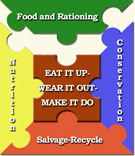

 |
|
 |
|
 FOOD
FOOD | Shopping for the weekly groceries was much different for the housewife of the 1940s. The milkman delivered dairy products to the door. Many farmers still sold fresh produce door to door and meat was often purchased at an independent butcher shop. A blue token had to be presented to the butcher for the allotted two pounds of meat per person per week. The grocer sold canned goods and other necessities in bulk. Wrapping consisted of brown paper or paper bags. There was little garbage created. |